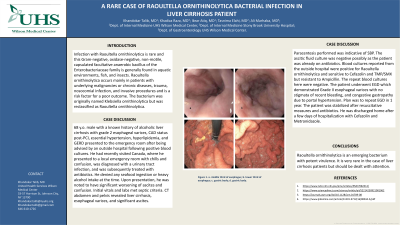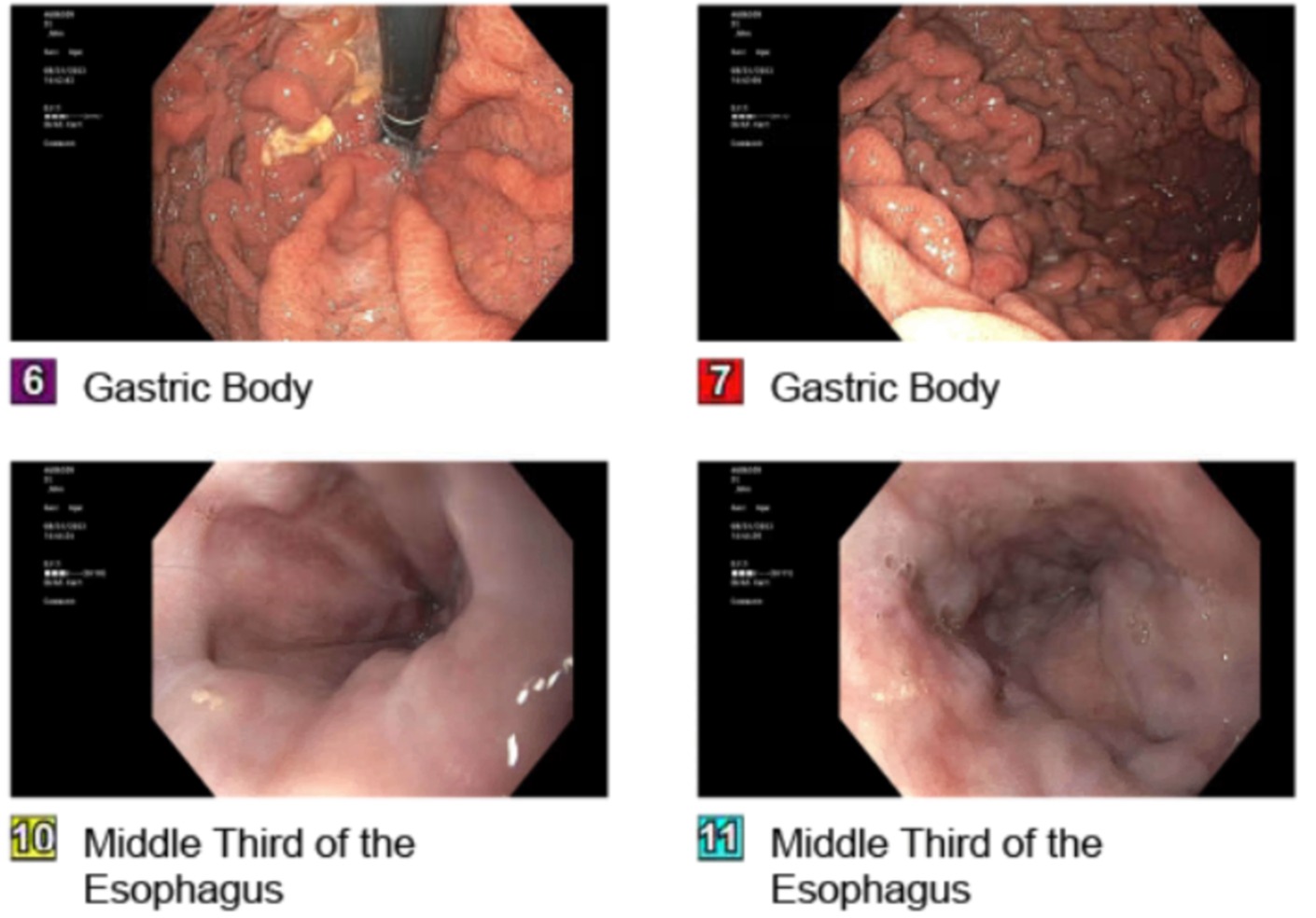Monday Poster Session
Category: Liver
P2448 - A Rare Case of Raoultella ornithinolytica Bacterial Infection in Liver Cirrhosis Patient
Monday, October 23, 2023
10:30 AM - 4:15 PM PT
Location: Exhibit Hall

Has Audio

Khandokar A. Talib, MD
United Health Services Hospital
Vestal, NY
Presenting Author(s)
Khandokar A. Talib, MD1, Khadija Raza, MD1, Ibrar Atiq, MD1, Tasnima Elahi, MD2, Ali Marhaba, MD1
1United Health Services Hospital, Johnson City, NY; 2Stony Brook University, Stony Brook, NY
Introduction: Infection with Raoultella ornithinolytica is rare and this Gram-negative, oxidase-negative, non-motile, capsulated facultative anaerobic bacillus of the Enterobacteriaceae family is generally found in aquatic environments, fish, and insects. Raoultella ornithinolytica occurs mainly in patients with underlying malignancies or chronic diseases, trauma, nosocomial infection, and invasive procedures and is a risk factor for a poor outcome. The bacterium was originally named Klebsiella ornithinolytica but was reclassified as Raoultella ornithinolytica.
Case Description/Methods: 68 y.o. male with a known history of alcoholic liver cirrhosis with grade 2 esophageal varices, CAD status post-PCI, essential hypertension, hyperlipidemia, and GERD presented to the emergency room after being advised by an outside hospital following positive blood cultures. He had recently visited Canada, where he presented to a local emergency room with chills and confusion, was diagnosed with a urinary tract infection, and was subsequently treated with antibiotics. He denied any seafood ingestion or heavy alcohol intake at the time.
Upon presentation, he was noted to have significant worsening of ascites and confusion. Initial vitals and labs met septic criteria. CT abdomen and pelvis revealed liver cirrhosis, esophageal varices, and significant ascites. Paracentesis performed was indicative of SBP. The ascitic fluid culture was negative possibly as the patient was already on antibiotics. Blood cultures reported from the outside hospital were positive for Raoultella ornithinolytica and sensitive to Cefazolin and TMP/SMX but resistant to Ampicillin. The repeat blood cultures here were negative. The patient underwent EGD which demonstrated Grade II esophageal varices with no stigmata of recent bleeding, and congestive gastropathy due to portal hypertension. Plan was to repeat EGD in 1 year. The patient was stabilized after resuscitative measures and antibiotics. He was discharged home after a few days of hospitalization with Cefazolin and Metronidazole.
Discussion: Raoultella ornithinolytica is an emerging bacterium with potent virulence. It is very rare in the case of liver cirrhosis patients but should be dealt with attention.

Disclosures:
Khandokar A. Talib, MD1, Khadija Raza, MD1, Ibrar Atiq, MD1, Tasnima Elahi, MD2, Ali Marhaba, MD1. P2448 - A Rare Case of Raoultella ornithinolytica Bacterial Infection in Liver Cirrhosis Patient, ACG 2023 Annual Scientific Meeting Abstracts. Vancouver, BC, Canada: American College of Gastroenterology.
1United Health Services Hospital, Johnson City, NY; 2Stony Brook University, Stony Brook, NY
Introduction: Infection with Raoultella ornithinolytica is rare and this Gram-negative, oxidase-negative, non-motile, capsulated facultative anaerobic bacillus of the Enterobacteriaceae family is generally found in aquatic environments, fish, and insects. Raoultella ornithinolytica occurs mainly in patients with underlying malignancies or chronic diseases, trauma, nosocomial infection, and invasive procedures and is a risk factor for a poor outcome. The bacterium was originally named Klebsiella ornithinolytica but was reclassified as Raoultella ornithinolytica.
Case Description/Methods: 68 y.o. male with a known history of alcoholic liver cirrhosis with grade 2 esophageal varices, CAD status post-PCI, essential hypertension, hyperlipidemia, and GERD presented to the emergency room after being advised by an outside hospital following positive blood cultures. He had recently visited Canada, where he presented to a local emergency room with chills and confusion, was diagnosed with a urinary tract infection, and was subsequently treated with antibiotics. He denied any seafood ingestion or heavy alcohol intake at the time.
Upon presentation, he was noted to have significant worsening of ascites and confusion. Initial vitals and labs met septic criteria. CT abdomen and pelvis revealed liver cirrhosis, esophageal varices, and significant ascites. Paracentesis performed was indicative of SBP. The ascitic fluid culture was negative possibly as the patient was already on antibiotics. Blood cultures reported from the outside hospital were positive for Raoultella ornithinolytica and sensitive to Cefazolin and TMP/SMX but resistant to Ampicillin. The repeat blood cultures here were negative. The patient underwent EGD which demonstrated Grade II esophageal varices with no stigmata of recent bleeding, and congestive gastropathy due to portal hypertension. Plan was to repeat EGD in 1 year. The patient was stabilized after resuscitative measures and antibiotics. He was discharged home after a few days of hospitalization with Cefazolin and Metronidazole.
Discussion: Raoultella ornithinolytica is an emerging bacterium with potent virulence. It is very rare in the case of liver cirrhosis patients but should be dealt with attention.

Figure: EGD demonstrated Grade II esophageal varices with no signs of recent bleeding.
Disclosures:
Khandokar Talib indicated no relevant financial relationships.
Khadija Raza indicated no relevant financial relationships.
Ibrar Atiq indicated no relevant financial relationships.
Tasnima Elahi indicated no relevant financial relationships.
Ali Marhaba indicated no relevant financial relationships.
Khandokar A. Talib, MD1, Khadija Raza, MD1, Ibrar Atiq, MD1, Tasnima Elahi, MD2, Ali Marhaba, MD1. P2448 - A Rare Case of Raoultella ornithinolytica Bacterial Infection in Liver Cirrhosis Patient, ACG 2023 Annual Scientific Meeting Abstracts. Vancouver, BC, Canada: American College of Gastroenterology.
